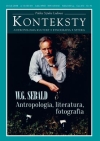Karska & Went & Duszeńko. O dwoistej naturze monumentu i jego wystawiania
Karska & Went & Duszeńko. On the Dual Nature of the Monument and Exhibiting It
Author(s): Marta LeśniakowskaSubject(s): Anthropology
Published by: Instytut Sztuki Polskiej Akademii Nauk
Keywords: Karska; Went; Duszeńko
Summary/Abstract: With the concepts of mise-en-scène, event (Mieke Bal), archival turn, and preposterousness as its points of departure the text embarks upon an extensive interpretation of the newest project by Alicja Karska and Aleksandra Went, who working together often undertake the problem of recovering for culture that which is forgotten, omitted, and excluded. The author took into consideration the fact that the performative dimension of the art studio is included into the museological order together with its ritual of forgetting and recalling: the studio is a repository of objects awaiting their disclosure and introduction into social space, ergo, to be given a new life. The Karska & Went project: Franciszek Duszeńko – Monuments is about an unknown sequence in the oeuvre of Franciszek Duszeńko (1925-2008). The authors of the exhibition extracted from his studio-refuge a dozen small abstract sculpture forms and by treating them as a sui generis archaeological finding transferred them into a specially constructed architectural space, i.e. models imitating museum or gallery interiors of the white cube type. In this way, they staged a mise-en-scène: a model of a museum/exposition situation in which a fragment of the artist’s studio conceived as non-space, i.e. that which is found on the peripheries of the existing orders, has been subjected to institutionalisation and engaged in a construction of a fictional museum/gallery. The essence of the applied artistic strategy is preposterousness: (neo)avantgarde sculptures, traces, documents, and relics pertaining to a certain moment in the artist’s oeuvre are seen from a present-day perspective and subsequently cited. In this fashion they become a contemporary product, causal for making another work of art. Applied/cited in present-day artistic praxis they attempt to solve the way in which, and reason why works of art from the past are always perceived as re-vision mediated by the horizon of contemporaneity. The quotation strategy employed in this assemblage is associated with interpretation and thus with conceptualisation. In other words, it is preposterous. This is also the objective of the Karska & Went project: the creation of a trans-historical artistic (cultural) situation that rejects the radicalism of divisions and severances in the history of art. The diverse strategies applied by Karska & Went: anachronism, preposterousness, mise-en-scène, mise-en-abyme, montage, collage, and quotation served the establishment of a new relation between the history of art and its present-day experiencing.
Journal: Konteksty
- Issue Year: 2014
- Issue No: 3-4
- Page Range: 307-312
- Page Count: 6
- Language: Polish
- Content File-PDF

